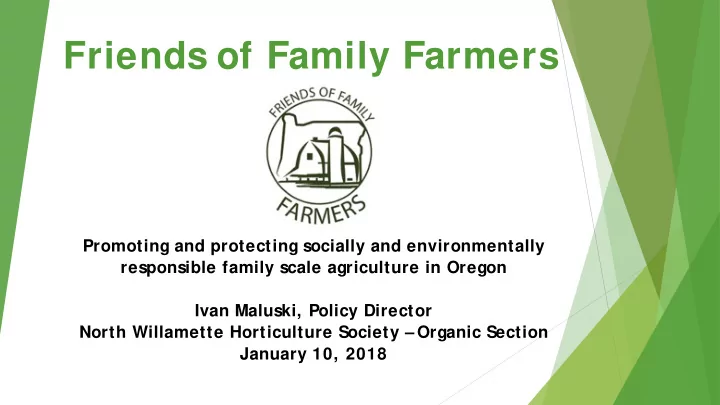

Friends of Family Farmers Promoting and protecting socially and environmentally responsible family scale agriculture in Oregon Ivan Maluski, Policy Director North Willamette Horticulture Society – Organic Section January 10, 2018
Who are we? Founded in 2005 Statewide reach – approx. 7000 members and supporters Focus on education and advocacy for family farmers and ranchers Blend of policy work, educational programming, and monitoring of regulatory agencies, the Legislature, and Congress Farmers and ranchers help establish our priorities via Listening Sessions Educate consumers (eaters) about ways to support family farms in Oregon
Four Main Program Areas Farmer Program – includes Listening S essions every other year, Oregon Pasture Network, Lobby Days at the S tate Capitol Eater Program - Consumer Education/ InF ARMation events Next Generation Program – BFR Access to Land/ Oregon Farm Link Watchdog Program –Tracking ODA, Board of Ag and the Legislature
Farmer and Rancher Listening Sessions/Surveys We Want to Hear from You! 2018 Farmer and Rancher Listening Sessions have begun – www.friendsoffamilyfarmers.org/listeningsessions/ 2018 Farmer and Rancher Surveys – www.friendsoffamilyfarmers.org/surveys/
2018 State Policy Issues Canola in the Willamette Valley ODA Rulemaking in 2018, Possible Legislation in 2019 Cap and Invest Climate Legislation in February 2018
Canola in the Willamette Valley Canola has been heavily regulated or banned in the Willamette Valley for many years Disease issues (ie blackleg), insect issues, concerns about impact on seed purity for specialty vegetable seed and cover crop seed markets 2013 Legislation extended moratorium on large-scale commercial canola production until 2019, allowing 500 acre research plots looking at similar issues in canola, radish and turnips Fall 2017 – OSU research results published Carol Mallory Smith – saw ‘no unique threat’ and stated ‘no reason to treat canola differently.’ Recommended ‘limiting canola production on set number of acres’ to be determined Fall 2018 – ODA must make rules or recommendations for future of canola in the WV. Moratorium expires 2019 Herbicide tolerant road-side canola See OSU report at www.oregon.gov/ODA/AboutUs/Documents/Board% 20of% 20Agricultur e/11-17/Canola% 20Report% 20Briefing.pdf
Questions on Canola in the Willamette Valley How much, if any, acreage is ok in 2019 and beyond? If allowed, how should it be regulated? Cap on acres – what level? Pinning systems - public or private? Is GMO canola ok, or blocked by rule/law? Where should boundaries of a Willamette Valley Protected Area be set?
Cap and Invest Climate Legislation Oregon Legislature introducing a ‘cap and invest’ greenhouse gas reduction bill for February 2018 session Ag exempt from regulation, but potential for funds for climate friendly farming practices via offsets or allowance payments from regulated industries Draft bill released January 8 Clean Energy Jobs Work group notes and draft bill - www.oregonlegislature.gov/helm/Pages/affrct.aspx Legislative Session runs Feb. 5 until March 11 Public hearings during week 1, committee votes on bills by Feb. 15
Cap and Invest Climate Legislation Caps greenhouse gas emissions from major polluters (ag is exempt) and sets up a pollution permit system to ensure cap is being met and to raise funds Sets up a 21-person Program Advisory Committee to advise DEQ on rule-making and program implementation. Advisory Committee would also recommend investment allocations to the Governor and the Legislature. Creates Climate Investment Fund (raising approximately $600 million per year) Potential funding source for farm practices like cover crops, no-till, composting, rotational grazing and other practices that sequester carbon in soil or protect working farm land from development Potential funding source for on-farm irrigation efficiency, small-scale renewable energy production, and other practices that reduce energy consumption
Cap and Invest Climate Legislation Climate Investment Fund Allocations: 60% to communities impacted by climate change, with at least 1/3 of this share dedicated to rural communities 20% for projects that increase carbon sequestration and resiliency in natural and working lands, including farms 20% for projects that either (i) reduce greenhouse gas emissions and make communities more resilient to the effects of climate change or (ii) increase carbon sequestration and heightened resiliency in natural and working lands. Includes ‘investments in agricultural or forestry practices that reduce greenhouse gas emissions or promote carbon sequestration … irrigation efficiency projects … . riparian zone restoration projects and methane recovery.’ Specific practices not specified in the bill Some practice funding may come through ‘offets,’ which must reduce GHG emissions or sequester carbon in ways that are ‘real, permanent, quantifiable, verifiable and enforceable’ Bill allows for ‘aggregation’ of multiple projects
Cap and Invest Climate Legislation What we are looking for in the final bill: Greater clarity that small and mid-sized farms will be eligible for a significant share of rural/ag-targeted funding opportunities Traditional ‘offset’ programs tend to benefit larger operations Clearer direction in the bill that specific organic and other practices that build or maintain healthy soils will be eligible for funding, including: use of cover crops, pasture-establishment, rotational grazing, use of compost, no-till, etc. Greater representation for small/mid-sized farmers and/or organic producers on the Program Advisory Committee Significant funding allocated as grants for practices, not solely ‘offset’ projects which are harder for smaller farms to qualify for
Next Steps FoFF 2018 Farmer and Rancher Listening Sessions have begun – www.friendsoffamilyfarmers.org/listeningsessions FoFF 2018 Farmer and Rancher Surveys – www.friendsoffamilyfarmers.org/surveys General Info and newsletter sign-up - www.friendsoffamilyfarmers.org NRCS COMET-Farm – whole farm or ranch carbon & greenhouse gas accounting system http://cometfarm.nrel.colostate.edu/
Thank you! www.friendsoffamilyfarmers.org
Recommend
More recommend